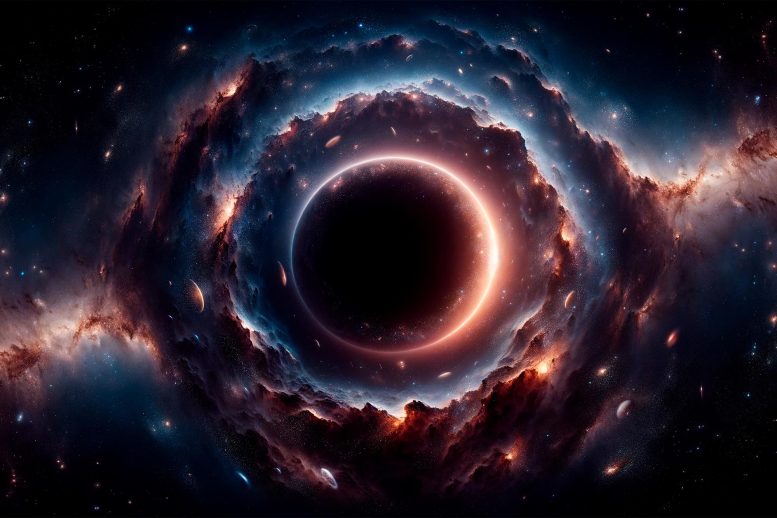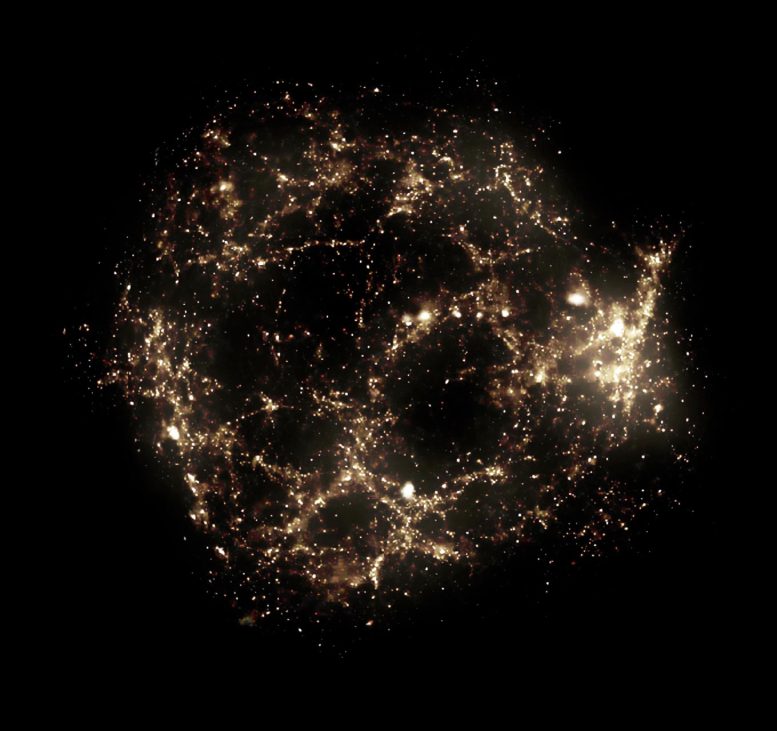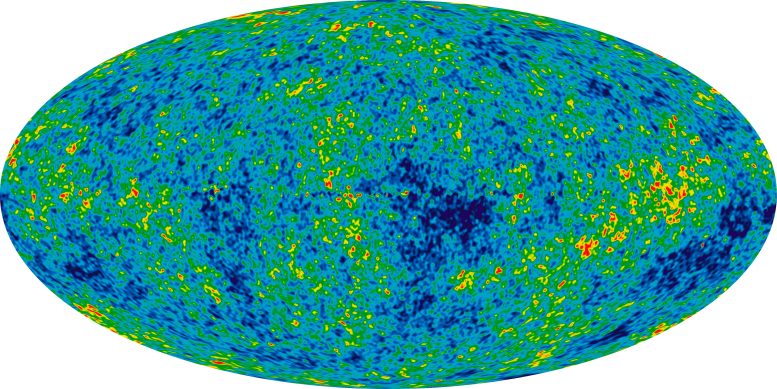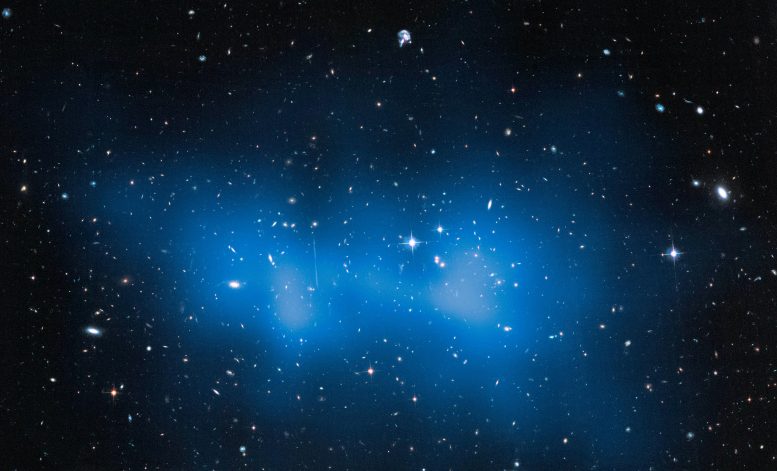
The recent “Hubble Tension” in cosmology, marked by conflicting expansion rate measurements, raises questions about the standard cosmological model. A new theory suggests that a giant, shallow void could account for these anomalies, challenging traditional views of the distribution of matter in the universe and suggesting a possible modification of Einstein’s theory of gravity.
Cosmologists propose a giant void in space as a solution to the “Hubble tension,” which challenges conventional models and suggests a revision of Einstein’s theory of gravity.
One of the great mysteries of cosmology is the rate at which the universe is expanding. This can also be predicted using the cosmological constant model Lambda-Cold Dark Matter (ΛCDM). The model is based on detailed observations of the light left over from light big bang – called the cosmic microwave background (CMP)
The expansion of the universe causes galaxies to move away from each other. The farther they go from us, the faster they move. The relationship between a galaxy’s speed and distance is governed by the “Hubble constant,” which is 43 miles (70 km) per second per megaparsec (an astronomical unit of length). It means a constellation Gets about 50,000 miles on it It is about every million light years away from us.
But unfortunately for the standard model, this value has recently been disputed, leading scientists to call “The Hubble Tension.” When we measure the expansion rate using nearby galaxies and supernovae (exploding stars), it is 10% higher than what we predict based on the CMB.

Artist’s impression of the giant void and the threads and walls surrounding it. Credit: Pablo Carlos Budassi
our New paper, we present one possible explanation: we live in a giant void (a region of less-than-average density) in space. We show that this can boost local scales with matter escaping from the vacuum. The denser regions around the vacuum will be ejected when it is disconnected – they will exert a greater gravitational force than the less dense material inside the vacuum.
In this scenario, we would have to be near the center of the void, about a billion light-years in radius and about 20% less dense than the average of the universe as a whole – so not completely empty.
Such a large and deep void is unexpected in the standard model – and therefore controversial. The CMP provides a snapshot of the structure of the infant universe, suggesting that matter today should be uniformly distributed. However, it directly calculates the number of galaxies in different regions Really recommend We are in a local vacuum.
Reversing the Laws of Gravity
We wanted to further test this idea by fitting various cosmological observations to the assumption that we live in a large vacuum that grew from a small density fluctuation at early times.
To do this, our model does not incorporate ΛCDM, but an alternative theory called modified Newtonian mechanics (monday)
MOND was first proposed to explain the anomalies in the rotation speeds of galaxies, leading to the suggestion of an invisible substance known as “dark matter”. MOND suggests that the anomalies can be explained by breaking down Newton’s law of gravity when gravity is very weak – as in the outer regions of galaxies.
The overall cosmic expansion history in MOND is similar to the standard model, but structure (such as galaxy clusters) grows faster in MOND. Our model captures what the local universe looks like in the MOND universe. We found that local measurements of the expansion rate today allow for fluctuations depending on our location.

CMB temperature fluctuations: A detailed, all-sky picture of the infant universe created from nine years of WMAP data reveals temperature fluctuations (shown as color differences) dating back 13.77 billion years. Credit: NASA / WMAP Science Team
Recent galaxy observations have allowed an important new test of our model in terms of predicted velocities at different locations. This can be done by measuring something called the bulk flow, which is the average velocity of matter, dense or not, in a given sphere. It varies with the radius of the sphere Recent observations showing It continues Up to a billion light years.
Interestingly, the total flow of galaxies of this size is four times faster than expected in the standard model. It also appears to increase with the size of the considered region, contrary to what the static model predicts. The probability of this matching the standard model is below one in a million.
This prompted us to see what our study predicts for total flow. We found that it gave good results match For observations. For that we need to be very close to the center of the void, and the void must be very empty at its core.
Case closed?
Our results come at a time when popular solutions to the Hubble tension are in trouble. Some believe we need more accurate measurements. Others think it can be solved given the high rate of expansion we measure locally A perfect one indeed. But that requires a small change in the expansion history of the early universe, so the CMB still looks correct.
Unfortunately, one influential review highlighted seven problems With this approach. If the universe expanded 10% faster than most of cosmic history, it would be 10% younger – paradoxical. Periods Primitive stars.
The existence of a deep and extended local void in the interstellar number and the fast observed total fluxes strongly suggest that ΛCDM grows faster than expected on scales of tens to hundreds of million light years.

This is a Hubble Space Telescope image of the most massive galaxies ever seen when the universe was half its current age of 13.8 billion years. Clusters of hundreds of galaxies orbit under a collective gravitational pull. The cluster’s total mass, refined in the new Hubble measurements, is estimated to weigh about 3 million billion stars similar to our Sun (about 3,000 times larger than our own Milky Way galaxy) — though much of the mass is hidden. as dark matter. The location of the dark matter is mapped in the blue overlay. Because dark matter doesn’t emit any radiation, Hubble astronomers can instead precisely measure how its gravity changes images of distant background galaxies like a funhouse mirror. This allowed us to come up with a mass estimate for the cluster. In 2012, the cluster was nicknamed El Gordo (Spanish for “the fat”) when X-ray observations and kinematic studies first suggested that it was unusually massive for its time in the early universe. Hubble data confirmed that the cluster is undergoing a violent merger between two smaller clusters. Credit: NASA, ESA and J. Jee (University of California, Davis)
Interestingly, we know that the massive galaxy cluster El Gordo (see image above) was formed. Too early Cosmic history has too many masses and collisional velocities to be compatible with the Standard Model. This is further evidence that structure evolves very slowly in this model.
Since gravity dominates on such large scales, we must extend Einstein’s theory of gravity to general relativity—but only on scales. Larger than a million light years.
However, we have no good way to measure how gravity works on very large scales – there are no objects bound by massive gravitational forces. General relativity is valid and comparable to observations, but it is precisely this approach that leads to the most serious tensions that our best cosmological model currently faces.
Einstein is thought to have said that problems cannot be solved by the same thinking that created them in the first place. Although the necessary changes may not be drastic, we may have seen the first reliable evidence in more than a century that we need to change our theory of gravity.
Written by Indranil Panik, postdoctoral researcher in the Department of Astrophysics at the University of St Andrews.
Adapted from an originally published article Conversation.![]()